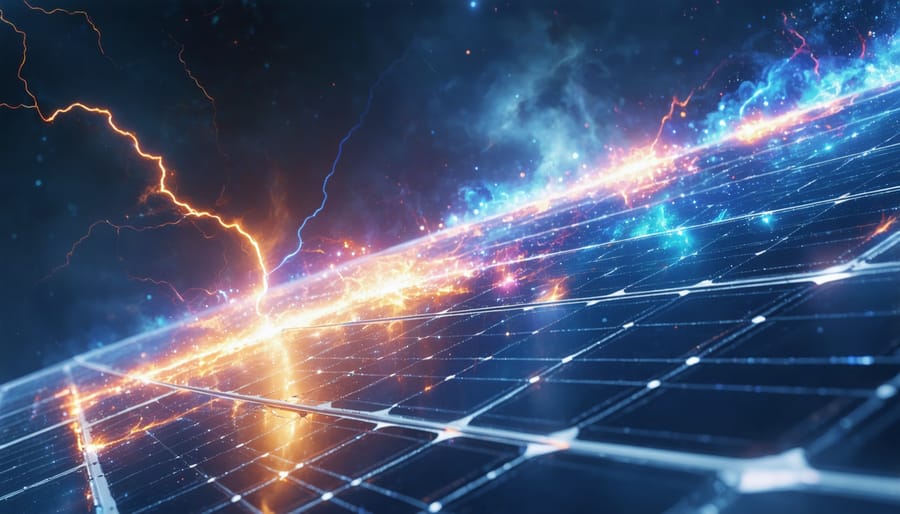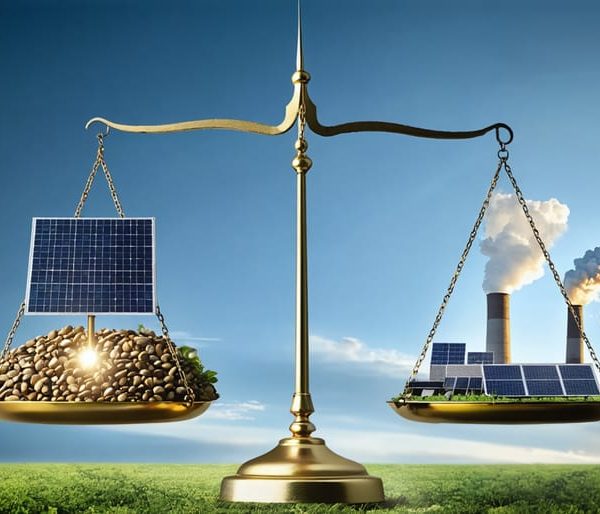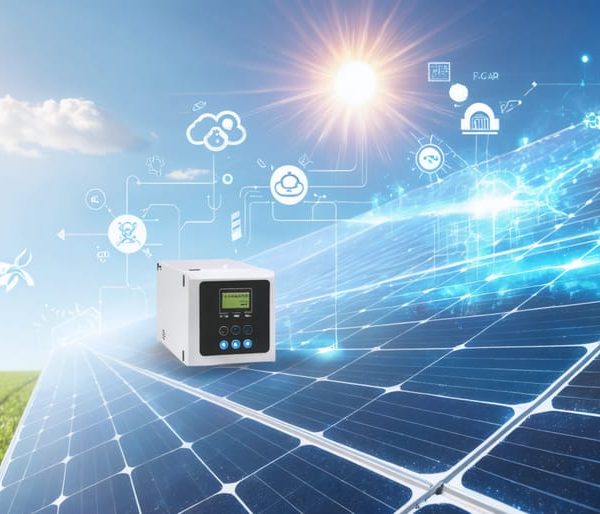Solar Storms: Hidden Risks to Your Home Solar System (And How to Protect It)
Solar storms – nature’s most spectacular cosmic events – can indeed pose serious risks to our modern way of life, but their direct danger to human health might surprise you. While these massive bursts of solar energy and magnetic fields hurling through space sound intimidating, Earth’s atmosphere and magnetic field act as our natural shield, protecting us from their most harmful effects.
What’s truly concerning isn’t the immediate impact on our bodies, but rather the potential disruption to the technology we’ve grown dependent on. From GPS navigation to power grids, and even your home’s solar installation, these celestial phenomena can temporarily disrupt or permanently damage critical infrastructure that keeps our society running smoothly.
For homeowners with solar installations and tech-savvy individuals alike, understanding solar storms isn’t about fear – it’s about being prepared and informed. While we can’t stop these powerful solar events, we can certainly protect our investments and adapt our systems to weather these cosmic storms effectively.

How Solar Storms Impact Your Solar Installation
Direct Physical Effects
Solar storms can have significant effects on solar energy systems, particularly impacting two crucial components: solar panels and inverters. When intense solar activity occurs, the excess electromagnetic radiation can temporarily reduce solar panel efficiency by up to 20%. This happens because the additional radiation interferes with the panels’ ability to convert sunlight into electricity effectively.
The inverters, which convert DC power from your panels into usable AC power, are especially vulnerable to these geomagnetic disturbances. During severe solar storms, voltage fluctuations can overload these sensitive components, potentially causing them to shut down or, in extreme cases, suffer permanent damage.
While this might sound concerning, modern solar equipment comes with built-in protection mechanisms. Most quality inverters include surge protection and automatic shutdown features that activate during extreme electromagnetic events. Additionally, solar panel manufacturers design their products to withstand various environmental stresses, including increased radiation exposure.
To put this in perspective, while solar storms can temporarily affect system performance, permanent damage is rare with properly installed, modern equipment. Regular maintenance and working with certified installers who understand these risks can help ensure your solar investment remains protected.
Grid Connection Risks
Solar storms pose a significant risk to our electrical grid systems, which can directly impact homes and businesses with solar installations. When intense solar activity sends powerful electromagnetic pulses toward Earth, these can overwhelm power grids and potentially cause widespread blackouts. Think of it as a massive power surge that can overload transformers and other electrical equipment.
For solar system owners, this means your grid-tied inverter might shut down as a protective measure during these events. While this safety feature prevents damage to your equipment, it also means your solar panels won’t generate power until grid stability is restored. This is particularly important because most residential solar systems are designed to automatically disconnect from the grid during power outages to prevent backfeeding, which could endanger utility workers.
The good news is that modern solar equipment comes with built-in protective features, and utility companies continuously monitor space weather conditions. To minimize risks, consider installing surge protectors and, if possible, adding battery storage to your system. This way, you can maintain power even if the grid experiences disruptions during a solar storm.
Protecting Your Solar Investment
Hardware Protection Solutions
When it comes to safeguarding your electrical equipment during solar storms, installing proper hardware protection is essential. To protect your solar panels and other sensitive electronics, consider implementing these reliable solutions.
High-quality surge protectors are your first line of defense. Look for models with a high joule rating (at least 2000) and UL certification. These devices act as a shield, redirecting excess electrical current safely to the ground during voltage spikes caused by solar storms.
Whole-house surge protectors offer comprehensive protection and can be installed directly in your main electrical panel. While more expensive than plug-in versions, they provide broader coverage for all your home’s circuits and connected devices.
For solar installations, specialized solar surge protection devices (SPDs) are crucial. These units are designed specifically to handle the unique characteristics of DC power from solar arrays and protect expensive inverters from damage.
Consider installing uninterruptible power supplies (UPS) for critical equipment. These battery backup systems not only protect against surges but also provide continuous power during outages, giving you time to safely shut down sensitive electronics.
Regular maintenance of these protective devices is essential. Most surge protectors have indicator lights showing their operational status – check these monthly and replace units that show signs of wear or damage.
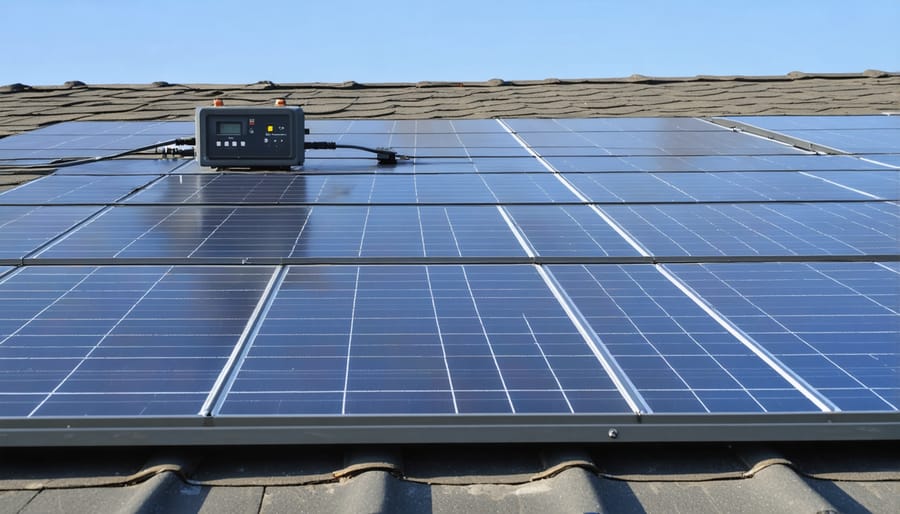
Smart Monitoring Systems
Today’s advanced monitoring systems play a crucial role in helping us prepare for and defend against severe weather events like solar storms. These sophisticated networks combine satellite technology, ground-based sensors, and artificial intelligence to provide early warnings and real-time tracking of solar activity.
The primary monitoring system is NOAA’s Space Weather Prediction Center, which operates 24/7 to track solar phenomena. Their network includes the DSCOVR satellite, positioned approximately one million miles from Earth, which provides up to 60 minutes of advance warning before a solar storm reaches us.
Ground-based magnetometers complement satellite data by measuring changes in Earth’s magnetic field, while solar observatories capture detailed images of the Sun’s surface activity. These tools work together to create a comprehensive monitoring network that helps protect our power grids, communication systems, and satellites.
When these systems detect potentially dangerous solar activity, they trigger automated alerts to power companies, telecommunications providers, and other critical infrastructure operators. This early warning system allows operators to take protective measures, such as adjusting power grid operations or safeguarding sensitive equipment.
For homeowners with solar installations, many modern solar inverters now include built-in monitoring capabilities that can detect unusual electrical activity and automatically shut down to protect your system during severe solar events.
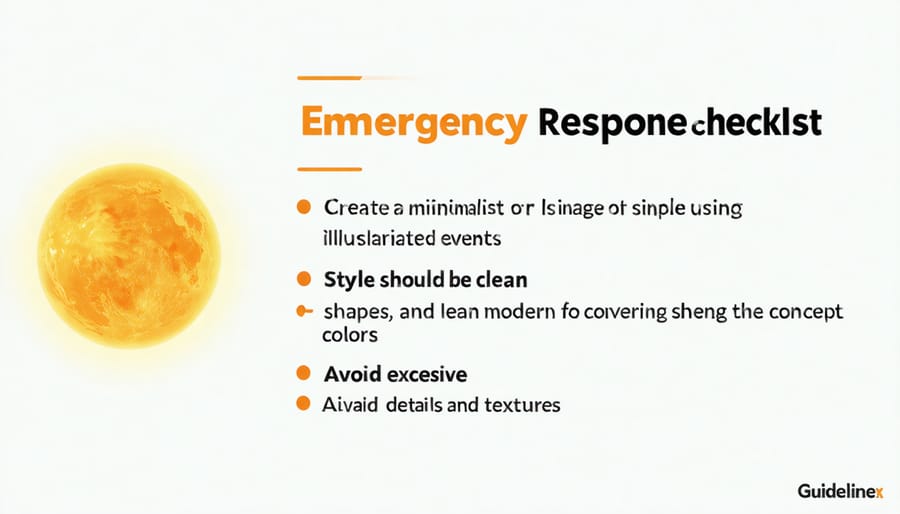
Emergency Response Plan
Before the Storm
When forecasters predict an incoming solar storm, taking proactive steps can help protect both your family and electronic devices. Start by staying informed through reliable space weather monitoring services like NOAA’s Space Weather Prediction Center, which provides regular updates and alerts.
Create an emergency kit containing essential supplies: flashlights, batteries, non-perishable food, and water. Review your home’s emergency response procedures with family members, ensuring everyone knows what to do if power or communications are disrupted.
Protect sensitive electronics by unplugging them when not in use and using surge protectors rated for severe electrical events. Back up important data to external drives or cloud storage, and keep mobile devices fully charged. If you have a solar power system, consult with your installer about built-in protective features and any additional precautions needed.
Consider installing a whole-house surge protector for comprehensive protection. These devices can help safeguard your electrical system from the intense currents that solar storms may induce in power grids.
During and After
During a solar storm, stay informed through reliable weather services and space weather forecasts. If a severe storm is predicted, consider disconnecting sensitive electronics and avoiding unnecessary use of GPS-dependent devices. Keep flashlights and battery-powered radios handy in case of power disruptions.
After the storm passes, conduct a thorough check of your electronic systems, particularly if you have a solar power installation. Look for any unusual behavior in your inverters or monitoring systems. Document any irregularities you notice, as this information might be valuable for warranty claims or insurance purposes.
For solar system owners, schedule an inspection with your maintenance provider to ensure all components are functioning correctly. Check your system’s performance data to identify any unexpected drops in energy production. If you notice any issues, contact your solar installer or maintenance team promptly.
Remember to reset any electronic devices that may have been affected and verify that your surge protectors are still functioning properly. Update your emergency preparedness plan based on any challenges you experienced during the storm.
Insurance and Warranty Considerations
When it comes to protecting your property from solar storm damage, understanding your insurance coverage is crucial. Most standard homeowners’ insurance policies don’t explicitly mention solar storm damage, creating potential coverage gaps that property owners should address proactively.
Contact your insurance provider to discuss specific coverage for electronics and electrical systems damaged by solar storms. Some insurers offer additional riders or specialized coverage for “acts of nature” that include severe space weather events. Commercial property managers should pay particular attention to this, as business interruption coverage may be necessary to protect against solar storm-related downtime.
For solar panel systems, warranty coverage varies significantly between manufacturers. While most warranties cover manufacturing defects and gradual performance degradation, damage from extreme space weather events might not be included. Review your solar equipment warranty documentation carefully, and consider additional protection plans if necessary.
Some tips for ensuring adequate coverage:
– Document your existing electronics and solar equipment with photos and serial numbers
– Keep maintenance records for all solar installations
– Consider surge protection coverage as a supplement to standard policies
– Ask about specific exclusions related to space weather events
– Review and update coverage annually as technology and risks evolve
Remember that prevention through proper surge protection and grounding systems can be as important as insurance coverage in protecting your investment from solar storm damage.
While solar storms pose real challenges to our modern technology-dependent world, understanding and preparation are key to managing these risks effectively. The good news is that our atmosphere provides excellent protection against most direct physical effects of solar storms on humans, especially those of us on Earth’s surface. However, we must remain vigilant about the indirect impacts through our electrical and communications infrastructure.
By staying informed through space weather forecasts, maintaining emergency supplies, and implementing protective measures for our electronic devices, we can significantly reduce our vulnerability to solar storm effects. For homeowners with solar installations, working with qualified professionals to install surge protection devices and following proper maintenance protocols can help safeguard your investment.
Remember, solar storms are a natural phenomenon that we’ve lived with throughout human history. With today’s advanced warning systems and protective technologies, we’re better equipped than ever to handle these events. By taking sensible precautions while avoiding unnecessary panic, we can continue to embrace solar technology while staying prepared for whatever our dynamic Sun may send our way.

